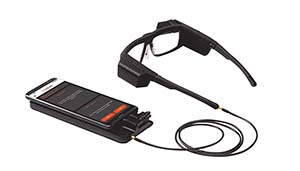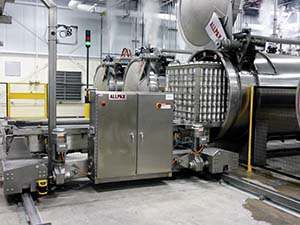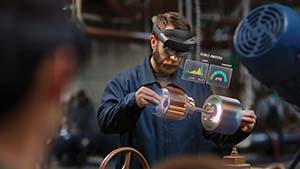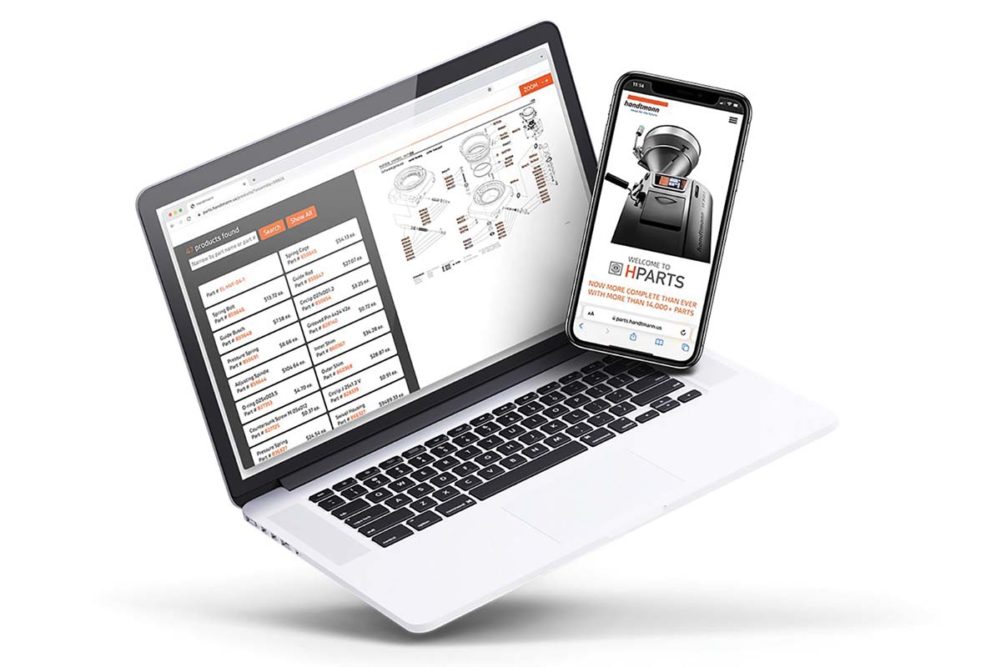This article was published in the March 2022 issue of Pet Food Processing. Read it and other articles from this issue in our March digital edition.
While the pandemic resulted in many adjustments for pet food manufacturers and suppliers, one major change was caused by restrictions on traveling and gathering, which forced many companies to get creative and embrace technology to facilitate product support services.
For instance, things like augmented reality glasses and expanded video production suites were implemented, and this tech made things easier for business to proceed without worry.
“The pandemic definitely changed the landscape of how we collaborate and how we communicate across project teams,” said Vince Naviello, a virtual design and construction manager at CRB, Rockville, Md.
One of the earliest problems caused by COVID-19 was not being able to get staff to the project sites because of restrictions, lockdowns and hesitations, so companies needed to think quick and come up with reliable solutions.
Getting creative
For CRB, one of the fastest things it implemented was remote assistance technology, using augmented reality glasses through the Microsoft HoloLens headset.
“This lets you see the world around you, but overlaying digital information into that environment,” Naviello said. “That really took off with utilizing this for remote assistance. With the staff we had on site, they would wear these headsets and make remote calls, and essentially could project what they were seeing on site and communicate back to those remote users.”
That meant they could share 3D models and plans and overlay the image into the physical environment to help move along the collaboration process.
“It was a technology that has been around but really hadn’t been used to the extent that the capabilities were there for,” Naviello said. “We also used it for virtual factory acceptance testing for equipment. Manufacturers that we had local and overseas could test the equipment to ensure it was good to go before shipping and installation in the field.”
Utilizing Autodesk’s 360 Photos was also very big this year for CRB. Naviello explained it essentially takes the concept of Google Street View and allows a virtual walking tour of a facility.
 Virtual Reality glasses allow live video streaming while supporting an overlay of technical data and drawings with microphone and speaker capabilities to facilitate remote communications. (Source: Handtmann)
Virtual Reality glasses allow live video streaming while supporting an overlay of technical data and drawings with microphone and speaker capabilities to facilitate remote communications. (Source: Handtmann)
“This gives eyes and greater visibility to the team who may not be able to get to a specific location, such as a project site for surveying,” he said. “That was key this past year and we continue to see growth with it.”
In late 2021, Lake Forest, Ill.-based Handtmann launched HVISION, its own augmented reality smart glasses technology. The glasses feature live motion video with optical and digital zoom lenses, heads-up display, Wi-Fi and cellular capability, ballistic rated construction, microphone and integrated speakers, and a laser pointer with QR and barcode reader capabilities.
“Handtmann Digital Solutions software helps to improve the equipment’s operational efficiency, reduce giveaway with batch-to-batch consistency and securely capture relevant equipment information to reduce downtime and maximize equipment utilization, and this all can be viewed remotely via any mobile device, if desired,” explained Kelly J. Tebon, aftermarket business unit manager for the company. “The AR tech places our technical support team with our customers’ maintenance teams virtually to walk them through the needed solution, using the powerful optical zoom camera that allows for hands-free communication and information sharing.”
Additionally, Handtmann has continued to develop HPARTS, an e-commerce site that offers more than 14,000 parts at one’s fingertips and allows customers to access assembly drawings to determine which parts are needed on their own time.
“It’s important to find the balance between innovation, productivity and ease of use for our end users,” said Vince Naviello, virtual design and construction manager at CRB.
“We are also beginning to integrate parts and equipment QR code capabilities with the goal of simplifying parts ordering online via HPARTS or through our parts department team,” Tebon said. “This improvement is being designed to help Handtmann customers maintain efficiencies while dealing with turnover and other labor experience related issues.”
For many years, Covington, La.-based Allpax has offered the capability of remote, secure access to Allpax retorts and automated handling control systems, which helps customers troubleshoot, diagnose, adjust and repair the equipment quickly and efficiently. That became even more important in 2020 and more tech was added to its solutions.
“We use this advanced tool extensively, particularly given all the travel challenges that have existed over the past two years,” said Jeff Arthur, technical sales director for Allpax. “Remote troubleshooting is all about achieving maximum equipment utilization. Allpax utilizes file sharing tools for making large files such as images, video and drawings readily available.”
Newer technology is receiving a great deal of use lately to collaborate with and support customers remotely. This includes programs like Microsoft Teams, WebEx and Zoom.
“Two or three years ago, we infrequently used these tools to collaborate internally or externally,” Arthur said. “Now, we use them daily and extensively.”
While Allpax has dabbled with augmented reality, right now for Allpax, the benefits do not meet or exceed other technology that is available and working well for the company.
 With remote, secure access to retorts and automated handling control systems, technicians can troubleshoot in real time, diagnose, adjust, and support the physical repair of these systems quickly and efficiently. (Source: Allpax)
With remote, secure access to retorts and automated handling control systems, technicians can troubleshoot in real time, diagnose, adjust, and support the physical repair of these systems quickly and efficiently. (Source: Allpax)
“We will continue to evaluate, however, such leading-edge technologies to see if they can meet the needs of our customers and personnel,” Arthur said.
Jeff Zeak, national development manager, bakery, Reiser, Canton, Mass., noted in recent years, due to people’s busy work schedules and with recent restrictions on travel, Reiser and its various divisions and partner companies have implemented several innovations with respect to being able to conduct sales calls, provide technical assistance, troubleshooting services and augment service call visits.
One of those innovations was utilizing online meeting and collaboration platforms such as Zoom and Microsoft Teams, which allows them to conduct virtual customer sales calls and support, attend trade shows, hold internal sales meetings, offer customer center machine application testing, factory acceptance tests of machines, answer augment machine technical service questions, troubleshooting and conduct service visits.
“Reiser offers the use of Secomea brand remote communication access devices to monitor and conduct corrective, preventative and predictive maintenance,” Zeak said. “This service is available to our staff and customers as a continuous monitoring service or as needed when problems arise.”
Additionally, JLS Robotics, a partner division of Reiser, utilizes virtual goggle technology to give plant tours and to troubleshoot their robotic line systems.
Wenger Manufacturing, Sabetha, Kan., has invested in a state-of-the-art video production suite that is currently under construction and is expected to assist communications and training with customers from any continent, and open minds to what can be realized in the future.
Importance of innovation
Innovation through tech creates opportunities to reduce costs for customers, reduce time to resolve problems, improve customer service and satisfaction, and minimize employee travel risk and burnout while increasing productivity and efficiency.
“When the pandemic hit, we looked for and began using tools that were immediately available and effective,” Arthur said. “To serve our customers, we need to be agile. The world continues to move faster and faster all the time, so innovating and using new effective tools is absolutely necessary to keep up and to meet or exceed customers’ expectations.”
 Headsets that combine the surrounding environment with an overlay of data allow on-site technicians to tap into their company’s off-site knowledge resources. (Source: Microsoft HoloLens)
Headsets that combine the surrounding environment with an overlay of data allow on-site technicians to tap into their company’s off-site knowledge resources. (Source: Microsoft HoloLens)
Tebon noted that many of Handtmann’s customers’ maintenance departments are shrinking, and product knowledge is on the decline due to retirements, so the company is constantly looking for technology that can help provide customers with the support they need — whether it’s onsite, over the phone or virtually — to help insure they experience minimal downtime and product loss.
When investigating innovative technology, Naviello noted that it must first be evaluated to ensure that it makes sense for the company and that the tool supports the process.
“There are a lot of developers out there introducing the latest and greatest tech, so part of my job is identifying the right tools and software and understanding how it works for our execution strategy,” he said. “It’s important to find the balance between innovation, productivity and ease of use for our end users.”
Getting people on board
Turning to something new isn’t always easy, as people are often reluctant to try new things.
“The primary challenge is educating people about the value of using a new procedure or tool so they will eagerly adopt a change,” Arthur said. “This is especially the case with something complex, and where there may be a steep learning curve. Diligence, patience and good support are key.”
Introducing AR to customers wasn’t easy at first for CRB, but Naviello said once they learned the value and benefits of using the technology, people quickly jumped on board and adapted well.
“It’s all about the training aspect of it and getting the team comfortable to perform the uses of the technology,” he said.
“The primary challenge is educating people about the value of using a new procedure or tool so they will eagerly adopt a change,” said Jeff Arthur, technical sales director for Allpax.
Companies must also work through the growing pains that can be caused by implementing new processes, procedures and technologies.
“Change is one of the biggest challenges we encounter with our customers, so when we are launching new technology, we always need to make sure we communicate how this new technology will be a benefit by making our customers’ lives easier,” Tebon said. “That’s why while in the development phase we include customers in our beta testing to insure whatever we launch has the customers’ needs in mind first and foremost.”
Innovation is expected to continue making a difference in the industry, as companies start experimenting with drones, digital twin technology, and other new tools to find new solutions that benefit all.
Read more news from pet food and treat industry suppliers.




